Angelo
Hungarian Pál Funk (1894-1974), under the name of Angelo, was a leading photographer of European celebrities during the 1920s and 1930s. The glamorous film star portraits of his Angelo Photos studio graced countless European postcards.

Hungarian postcard. Photo: Angelo, Budapest. Collection: Didier Hanson.
Hungarian actor Béla Lugosi (1882 –1956) is best known as the vampire Count Dracula in the Horror classic Dracula (1931). He started his film career in the silent Hungarian cinema and also appeared in German silent films. In the last phase of his career, he became the star of several of Ed Wood's low-budget epics and other poverty row shockers.

German postcard by Ross Verlag, no. 4591/2, 1929-1930. Photo: Angelo Photos.
Dita Parlo (1908-1971) was a popular European film star in the late 1920s and early 1930s. She inspired both Dita Von Teese and Madonna, who used Parlo's name & character from L'Atalante for her controversial Sex book and Erotica album.
Bettini
From 1908 on, Riccardo Bettini (c. 1880-1960) worked as a photographer in Rome. He published them as postcards with his own company, Edizione Società Anonima Italiana Bettini. The Museo di Roma has a large collection of his original negatives. It contains many pictures of the changing Rome of the first decades of the twentieth century, when old buildings were replaced by new ones. Bettini was close to the Italian royal family, the House of Savoy, and often portrayed them. Yet, few negatives remain of the hundreds of film and theatre actors Bettini photographed as well and which were used for the postcards.

Italian postcard by Ed. Soc. Anon. Bettini, Roma, no. 168. Photo: Riccardo Bettini.
Lyda Borelli (1887-1959) was already an acclaimed stage actress before she became the first diva of the Italian silent cinema. The fascinating film star, who reigned 1913-1918, caused a craze among female fans called 'Borellismo'.
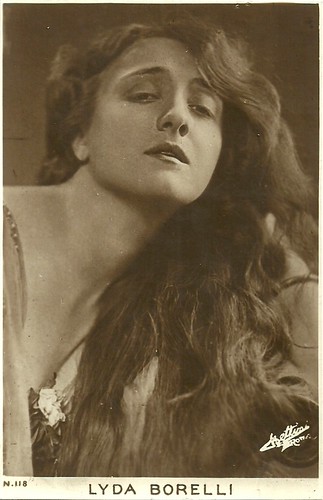
Italian postcard by Ed. Soc. Anon. Bettini, Roma, no. 118. Photo: Riccardo Bettini.
(Madame) D'Ora
Atelier d’Ora was one of the most important Austrian photo salons of the first decades of the 20th century. The studio was founded in 1907 by Dora Kallmus with the support of Arthur Benda, who was the technical director. Kallmus, who took the pseudonym Madame d’Ora in 1907, quickly became, with her studio, one of the most sought-after of Vienna's society photographers. She also portrayed many European film stars in her Vienna salon and, from 1925 on, also in her second studio in Paris.
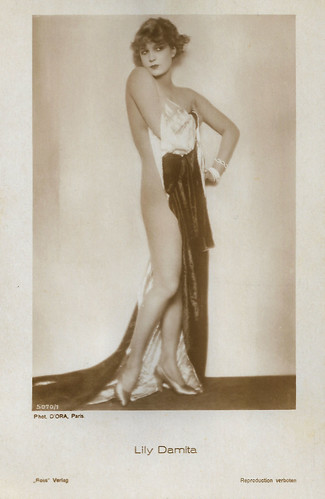
German postcard by Ross-Verlag, Berlin, no. 5070/1, 1930-1931. Photo: d'Ora, Paris.
Beautiful and seductive French actress Lily Damita (1902-1994) appeared in 33 French, Austrian and Hollywood films between 1922 and 1937. Her marriage to Errol Flynn was rather tempestuous and led to her nickname 'Dynamita'.

Austrian postcard by Iris Verlag, no. 640-1. Photo: D'Ora (Dora Kallmus).
Hungarian Maria Corda (1898-1975) was an immensely popular star of the silent cinema of Austria and Germany. The pretty, blonde actress was a queen of the popular epic spectacles of the 1920s, which were often directed by her husband, Alexander Korda.
Anny Eberth
In her Berlin studio, German photographer Anny Eberth portrayed aristocratic ladies and elegant fashion models, but also film actors and expressionist dancers, including the notorious Anita Berber. During the 1910s and 1920s, her photos were published in such Berlin magazines as Die Dame and Berliner Illustrierte Zeitung, and were used for many sepia film star postcards.

German postcard by Photochemie, Berlin, no. K. 2765. Photo: Atelier Eberth / Union. Pola Negri as Carmen in the German silent drama Carmen (Ernst Lubitsch, 1918).
Polish film actress Pola Negri (1897-1987) achieved notoriety as a femme fatale in German and American silent films between the 1910s and 1930s.

German postcard by NPG, no. 795. Photo: Anny Eberth, Berlin. Fritzi Massary in Die Rose von Stambul / The Rose of Stamboul (Felix Basch, Arthur Wellin, 1919).
Austrian-American soprano singer and actress Fritzi Massary (1882-1969) was one of the greatest 20th-century operetta divas. She was a superstar in Berlin and Vienna in the Weimar era, but after the rise of the Nazis, Massary was forced to flee Germany. In London, she appeared in an operetta that Noel Coward wrote for her. The popular singer also starred in several early German ‘sound pictures’ and other silent films.
Evans
Nelson Evans (1889-1922), who signed as "Evans, L.A.", was a photographer during the days of early Hollywood. Evans was known for his portraits of film actors such as Mary Pickford, Marie Prevost, Jackie Coogan, and many others during the silent film era, including director Philip Rosen. He is also considered one of the creators of pin-up photography.

French postcard by Cinémagazine-Edition, no. 29. Photo: Evans, L.A.
American actor John Leslie 'Jackie' Coogan (1914-1984) began as a child actor in silent films. He was Charlie Chaplin's irascible sidekick in The Kid (Charles Chaplin, 1921) and played the title role in Oliver Twist (Frank Lloyd, 1922). Many years later, he became known as Uncle Fester in the TV series The Addams Family (1964-1966). In the interim, he sued his mother and stepfather over his squandered film earnings ($48 million to $65 million adjusted for 2012 dollars) and provoked California to enact the first known legal protection for the earnings of child performers, widely known as 'the Coogan Act'.
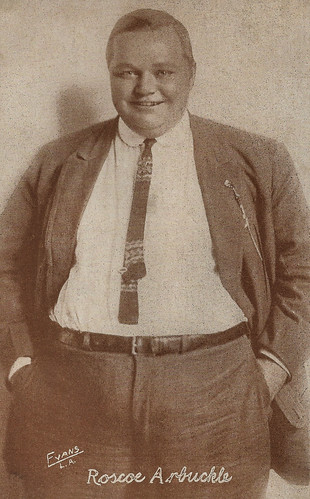
American Arcade card. Photo: Evans, L.A.
American silent film actor, comedian Roscoe ‘Fatty’ Arbuckle (1887-1933) was one of the most popular silent stars of the 1910s. He started at the Selig Polyscope and moved to Keystone Studios, where he worked with Mabel Normand and Harold Lloyd. Arbuckle mentored Charlie Chaplin and discovered Buster Keaton and Bob Hope. In 1920, he signed a contract with Paramount Pictures for US$1 million. Between November 1921 and April 1922, Arbuckle was the defendant in three widely publicised trials for the rape and manslaughter of actress Virginia Rappe. Following the trials, his films were banned, and he was publicly ostracised. Arbuckle later worked as a film director under the alias William Goodrich. He was finally able to return to acting, making short two-reel comedies in 1932 for Warner Bros. He died in his sleep of a heart attack in 1933 at age 46, reportedly on the same day he signed a contract with Warner Bros. to make a feature film.
Fontana
Fontana in Rome portrayed many divas and other stars of the Italian silent cinema. These portraits were reproduced for a series of popular postcards in sepia and later in black and white by Edizione A. Traldi in Milan.

Italian postcard by Ed. A. Traldi, Milano, no. 322. Photo: Fontana.
Italian actress Margot Pellegrinetti (1897-1966) was defined by the press at the time as the lady "with the strange face and the pensive eyes". Although this card and the photo must be at least 100 years old, the portrait looks astonishingly modern and contemporary.
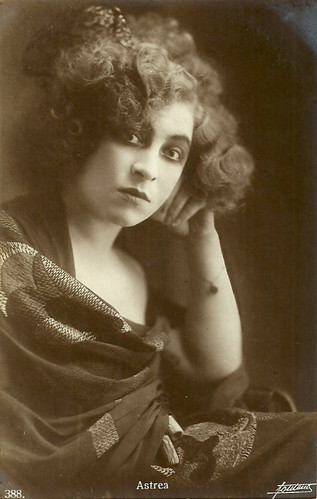
Italian postcard, no. 388. Photo: Fontana.
Astrea was the enigmatic female ‘forzuto’ of Italian silent cinema. Nothing is known about Astrea’s dates of birth and death, nor her original name. Some say she was a Venetian countess originally, others claim she came from the circus, and the last name of Barbieri is mentioned.
E.O. Hoppé
British photographer of German origin Emil Otto Hoppé (1878-1972) was one of the most successful photographers in London in the early decades of the twentieth century. He was highly celebrated as a portrait, travel, and topographic photographer. In 1927-1928, Hoppé did portrait sittings in Berlin and made photographs for the Ufa that were used for many film star postcards by Ross Verlag.
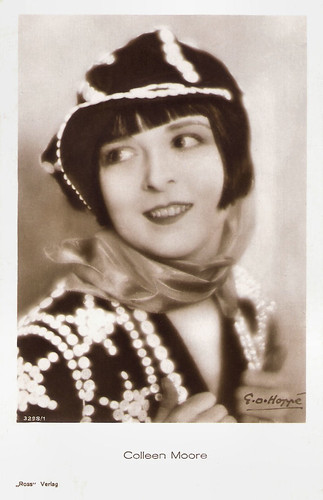
German postcard by Ross Verlag, no. 3298/1, 1928-1929. Photo: E.O. Hoppé.
American actress Colleen Moore (1899-1988) was a star of the silent screen who appeared in about 100 films beginning in 1917. During the 1920s, she put her stamp on American social history, creating in dozens of films the image of the wide-eyed, insouciant flapper with her bobbed hair and short skirts.
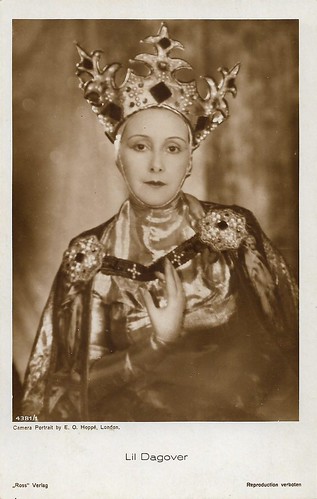
German postcard by Ross Verlag, no. 4381/1, 1929-30. Photo: E.O. Hoppé, London.
German, but Dutch-born film actress Lil Dagover (1887-1980) was an exotic, dark beauty who featured prominently during the golden age of the German silent cinema. She had her breakthrough as the prey of Dr. Caligari's monster in the classic expressionist film Das Cabinet des Dr. Caligari (1920), but gradually her fine and evanescent beauty changed, and she turned into a 'Salondame', a lady of the screen. Her career would span nearly six decades.
Studio Lorelle
Lucien Lorelle (1894-1968) was one of the great photographers of the early twentieth century. In his Studio Lorelle, he portrayed all the great French artists of his time.
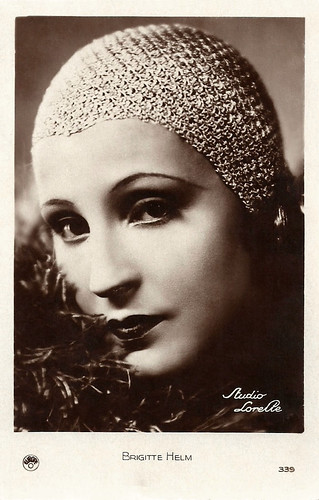
French postcard by Cine-Europe, no. 339. Photo: Studio Lorelle.
German actress Brigitte Helm (1908-1996) is still famous for her dual role as Maria and her double, the evil Maria, the Maschinenmensch, in the silent SF classic Metropolis (Fritz Lang, 1927). After Metropolis, she made a string of over 30 films in which she almost always had the starring role. She easily made the transition to sound films before she abruptly retired in 1935.

French postcard in the Europe series, no. 66, ca. 1932. Photo: Studio Lorelle.
Dick van Maarseveen
The Dutch photographer Dick van Maarseveen (1905-1990) was in the 1930s famous for his star portraits and film stills. After the war, he concentrated on corporate photography, but Van Maarseveen also moved into the field of advertising and fashion photography. In his spare time, he did nude photography. A special section of his oeuvre is the pictures he made as a prisoner of war in Camp Muhlberg during World War II.
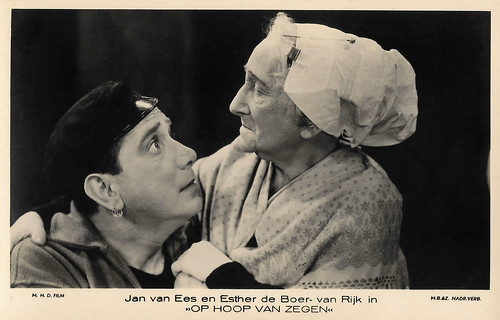
Dutch postcard by M.B. & Z. (M. Bonnist & Zonen, Amsterdam). Photo: Dick van Maarseveen, Den Haag / M.H.D. Film. Jan van Ees and Esther de Boer-van Rijk in Op Hoop van Zegen / The Good Hope (Alex Benno, Louis Saalborn, 1934).
'Op Hoop van Zegen' (1900) (Dutch for 'Trusting Our Fate in the Hands of God') is a classic Dutch play about a fisherman's tragedy. It is still staged and remains the most popular play by Dutch dramatist Herman Heijermans. He was the leading Dutch dramatist at the close of the 19th century. He was a writer of strong, realistic and socialist tendencies who single-handedly brought Dutch theatre into the modern age. There are four films based on the play, produced in 1918, 1924, 1934, and 1986. The 1934 version won a special mention at the Venice Film Festival of 1935.

Dutch postcard by M.B. & Z. (M. Bonnist & Zonen, Amsterdam). Photo: Dick van Maarseveen, Den Haag / Nationaal Film. Fien(tje) de la Mar in Op stap / On the Move (Ernst Winar, 1935).
Legendary Fien de la Mar (1898-1965) was one of the few real film stars of the Netherlands. She starred in films in the 1930s when German emigrants like Douglas Sirk, Ludwig Berger and Max Ophüls created a Dutch Hollywood.
Manassé
Atelier Manassé was a legendary Austrian photo studio that captured the golden age of cinema and cabaret in Vienna of the 1920s and 1930s. The studio was founded by Olga Spolarics and her husband Adorján von Wlássics.

Austrian postcard by Iris-Verlag, no. 5070. Photo: Manassé, Wien.
Polish-born, German actress Dina Gralla (1905-1994) often appeared as a naïve, sexy dancer in German revues and in more than 35 silent and early sound films.

German postcard by Ross Verlag, no. 5477/1, 1930-1931. Photo: Atelier Manassé, Wien (Vienna).
Anna May Wong (1905-1961) was the first Chinese American movie star and the first Asian American actress to gain international recognition. Frustrated by the stereotypical supporting roles she reluctantly played in Hollywood, Wong left for Europe, where she starred in such classics as Piccadilly (1929).
Frieda Riess
German photographer Frieda Riess (1890-ca. 1955) had a studio in central Berlin. Her sitters included Albert Einstein, Benito Mussolini, Josephine Baker, Jack Dempsey, and many film stars. She also worked as the stills photographer on Fritz Lang’s films.

German postcard by Ross Verlag, no. 363/1, 1919-1924. Photo: Frieda Riess.
Grit Hegesa (1891–1972) was a German dancer and silent film actress. She appeared in seventeen films, including Ewald André Dupont's crime film Whitechapel (1920).

German postcard by Ross Verlag, no. 478/2, 1919-1924. Photo: Riess.
Bartolomeo Pagano (1878-1947) was an Italian actor in Italian and German silent film. His name is forever attached to the character of the strong man Maciste.
Hanni Schwarz
Hanni Schwarz was a German portrait, dance and nude photographer who was active in Berlin from 1901 onwards. She was a well-known professional photographer in the German Empire at the beginning of the twentieth century. During the 1920s, Ross Verlag and Verlag Hermann Leiser featured many of her studio's film star portraits on their postcards.
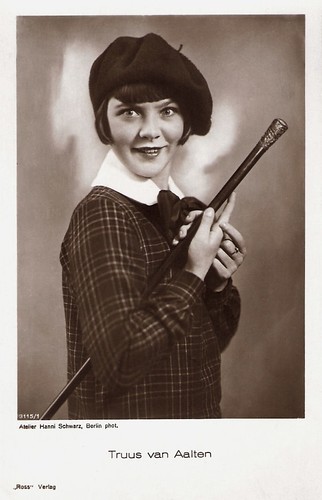
German postcard by Ross Verlag, no. 3115/1, 1928-1929. Photo: Atelier Hanni Schwarz, Berlin.
Dutch film star Truus van Aalten (1910-1999) made 29 films in the 1920s and 1930s, and only one of them in the Netherlands.
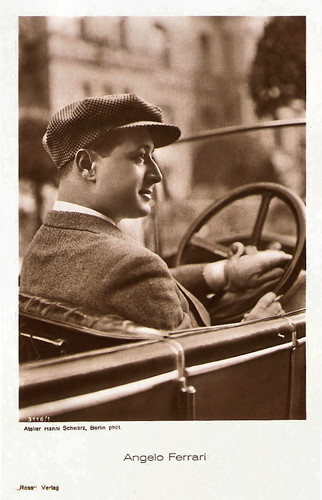
German postcard by Ross Verlag, no. 3116/1, 1928-1929. Photo: Atelier Hanni Schwarz.
Italian actor Angelo Ferrari (1897-1945) appeared in nearly 200 films. He started his career in Italian silent films and later got a strong foothold in the German cinema.
Emilio Sommariva
Emilio Sommariva (1883-1956) was a Milanese studio photographer and painter who, in the 1910s and 1920s, portrayed many of the Italian divas such as Lyda Borelli, Diana Karenne, and Helena Makowska, but also stars of prose and vaudeville like Anna Fougez. His original works are kept at the Brera Museum in Milan.

Italian postcard by Ed. A. Traldi, Milano, no. 541. Photo: Emilio Sommariva, Milano.
Anna Fougez (1894-1966) was a vaudeville star who shone on the Italian stage from the First World War to the mid-1920s. She also played in various Italian films.

Italian postcard by Ed. A. Traldi, Milano, no. 546. Photo: Emilio Sommariva, Milano. The photo was part of a photo shoot Sommariva did of Fougez in 1922.
Walery
Stanisław Julian Ignacy Ostroróg, also known as Walery (1863-1929), was a Polish photographer active in London and Paris between 1890 and 1929. After inheriting his father's name and photographic studio in London, he continued with portraiture for about a decade until the turn of the century, when he moved definitively to Paris. There, he achieved celebrity as an innovator and accomplished photographer of cabaret stars and of the female form.

French postcard. Photo: Walery, Paris. Mayol as Dandy and Arlette Dorgère as Prince Charming in the stage production 'Cinderella' (1906) at Théâtre de la Porte Saint-Martin in Paris. Caption: en route.
Félix Mayol (1872-1941) was a popular French singer of the Belle Époque. He became a success in Paris in 1895 as a singer performing in a campy, effeminate way. His hair tassel inspired many imitators. In 1905, he performed at Gaumont in 14 phonoscènes under the direction of Alice Guy.
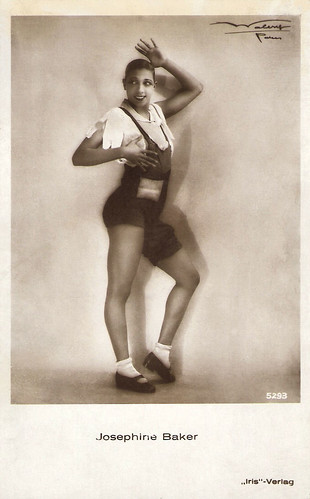
Austrian postcard by Iris Verlag, no. 5293. Photo: Waléry, Paris.
Josephine Baker (1906-1975) was well-known as a singer and dancer. In 1925, she became an instant success in Paris because of her erotic dance. She also performed in a handful of silent and early sound films, La Sirene des Tropiques (1927), Zouzou (1934) and La princesse TamTam (1935).
Witzel
Albert Witzel was a pioneer and prominent portrait photographer of Los Angeles. He was born in 1871 and died in 1929 after a long illness. The rise of his studio paralleled the emergence of the film industry following its relocation from the East Coast. Witzel made portraits of many of Los Angeles' leading figures, including such film icons as Charlie Chaplin, Harold Lloyd and Theda Bara.

French postcard by Cinémagazine-Edition, no. 106. Photo: Albert Witzel, Los Angeles.
Theodore Roberts (1861–1928) was an American stage and screen actor, known for his many parts in films by Cecil B. DeMille and his brother William.
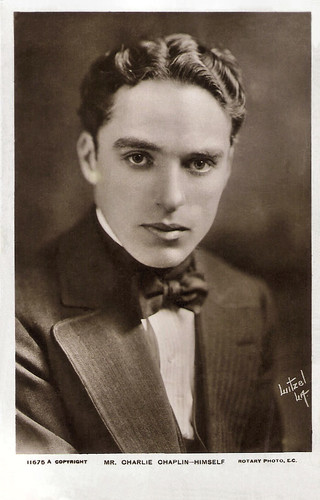
British postcard by Rotary, no 11675 A. Photo: Witzel.
In 1914, English comedian Charles ‘Charlie’ Chaplin (1889-1977) invented his classic character the Tramp! With his toothbrush moustache, undersized bowler hat and bamboo cane, the tramp struggled to survive while keeping his dignity in a world with great social injustice. Chaplin was one of the most creative and influential personalities of the silent film era. He used mime, slapstick and other visual comedy routines, and he not only starred in his films, but also directed, wrote and produced them, and composed the music as well.
Wyndham
The British society portrait photographer Olivia Wyndham (1897-1967) was a talented bohemian who was an important photographer of the 'bright young things' of the 1920s. In France, some of her exquisite photos of stage and film actors were published as sepia-coloured postcards by her own company, Wyndham Ed.
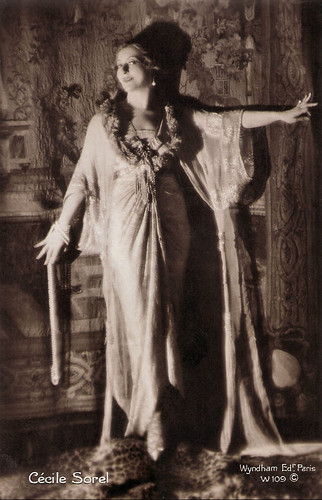
French postcard by Wyndham Ed., no. W 109.
Legendary actress Cécile Sorel (1873-1966) was the ‘queen of the French stage’ during the Belle Epoque, the period between the Paris Exposition of 1900 and the First World War. Her public appearances, often in extravagant costumes, created a sensation. During her long life, she played in five films.
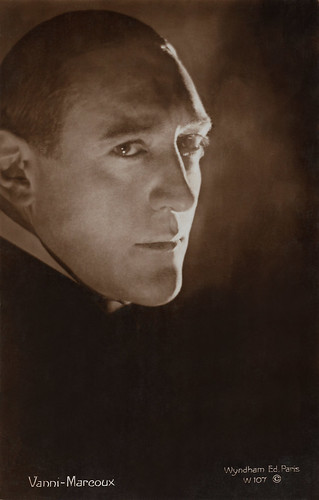
French postcard by Wyndham Ed., Paris, no. W 107. Vanni Marcoux's name was also written with a hyphen.
Jean-Émile Diogène Marcoux (1877–1962) was a French operatic bass-baritone, known professionally as Vanni Marcoux (aka Vanni-Marcoux), and renowned as one of the most memorable singing-actors of the 20th century. Marcoux only acted in 4 films, but these were leads as Faust in Don Juan et Faust (Marcel L'Herbier, 1922), as Maurice Ferrioul in the Franco-British coproduction The Scandal (Arthur Rooke, 1923), as Charles le Téméraire in Le Miracle des Loups (Raymond Bernard, 1924), and as Vitalis in Sans famille (Marc Allégret, 1934).
No comments:
Post a Comment